Waffen-SS Collar Tabs
Introduction
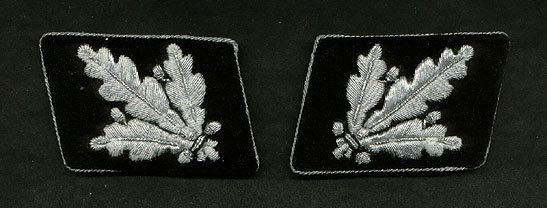 SS Brigadeführer Collar tabs
SS Brigadeführer Collar tabs
One of the
most distinguishing and recognizable examples that set the Waffen-SS aside from all others
was the rune SS collar tab. The runic SS collar tab was first worn by the "Leibstandarte
SS Adolf Hitler" and subsequent political units such as "Deutschland," "Germania" and
"Der Fuhrer."
In 1944 prior to the battle in the Ardennes, Reichsführer SS Himmler addressed his SS-men
"Prove yourselves
worthy of your victory runes, so order so."
This underlines the importance of the
rune symbology within the Waffen-SS.
The design of the dual Sieg-runes was initiated in May 1933,
by SS-Sturmhauptführer and
graphic artist Walter Heck, who sold his design to the SS for 2.50Rmks.
|
SS COLLAR TABS
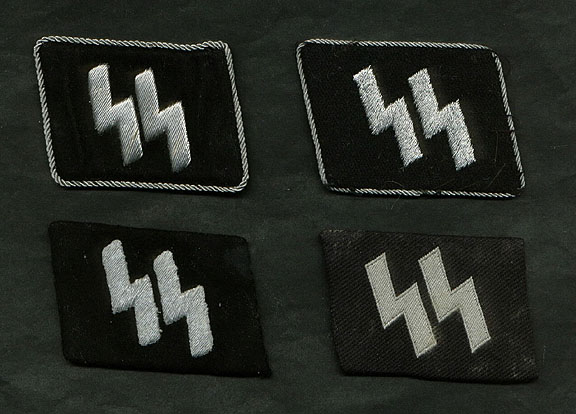 SS collar tabs
SS collar tabs
The Runic SS collar tabs were produced in silver aluminum thread for officers and silver
grey thread for enlisted. The SS tabs were either hand-embroidered or
machine-woven.
Both the officer and enlisted collar tabs were issued and worn by all SS men including
foreign volunteers.
On top is an SS officer collar tab. The velvet base and twisted silver/aluminum piping
indicate this collar tab was worn by ranks of SS-Sturmbannführer to Reichsführer
between May 1933 to October 1934 and by ranks of SS-Untersturmführer to
Reichsführer from October 1934 to May 1945.
Next is a rare late war Dachau issue
collar tab. The SS runes are made of silver/aluminum
thin threads on a black cotton cloth and twisted silver/aluminum piping.
Below is an Officer/NCO SS silver bullion collar tab embroidered on a black wool base.
Next is a standard BeVo style SS rune collar tab. These weave style collar
tabs have distinctive white buckram shown on the back.
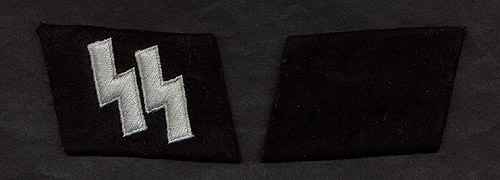 SS collar tabs
SS collar tabs
Unused SS NCO/enlisted
RZM pattern collar tab with machine embroidered silver-grey runes on a black doe wool base and
matching enlisted rank collar tab.
|
DEATH'S HEAD

The SS insignia was entrusted
to the "Reichszeugmeisterei (RZM),"
the Nazi Party organization that
overlook the production and pricing of all SS uniform items.
The metal Eagle and
Totenkopf insignias were attached on SS headgear.
In general, early insignias were made of tombak or CupAl (copper & aluminum) but because of
material shortages these badges were then later made of zinc.
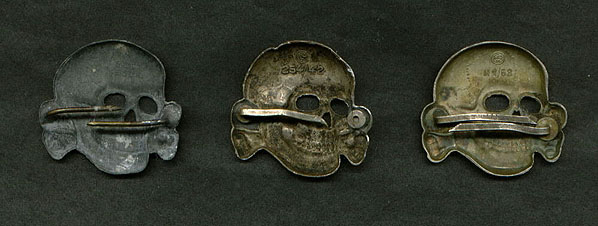
|
|
The "Totenkopf" (Death's Head) metal insignias were produced by RZM-approved companies.
Early to mid-war insignias were die struck with hollow backs bearing two flat prongs or round
pins. The badges normally bore the RZM marks as shown in the examples above.
The badge on your right is made of copper-aluminum and has the "RZM M1/52" marking, which
indicates that it was made by the firm of "Deschler & Sohn." Notice the flat prongs and round disc
pin attachments.
During the war the "M1" prefix was removed and only a two or three digit manufacturing code
was left with the addition of a year suffix.
Notice the reverse of the Totenkopf insignia made of
nickel-bronze, which has the "RZM 254/42" marking. According to some sources this badge was
also made by the firm "Deschler & Sohn." The reverse shows the typical style flat prongs and round
disc found on Deschler badges; this badge is missing one of the flat prongs.
The zinc badge on your left does not show the manufacturer's marking but the inscription "Ges
Gesch" This marking has been attributed to the firm "Assmann."
|
|
TOTENKOPF
COLLECTION
The "Totenkopf" (Death's
Head) was the other collar insignia that has been associated to Concentration
Guards and the famous 3rd SS Totenkopf Division. The death's head
was first worn as a collar tab when the SS took over the concentration camp system and
continued through the pre-war expansion period that created the core of the Totenkopf Division.
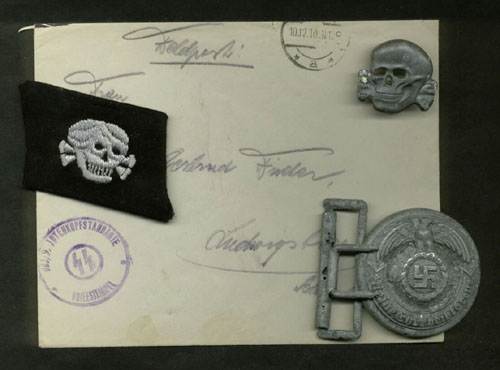 Totenkopf Collection
Totenkopf Collection
The Totenkopf Collar Tab
(Shown on your left), was only worn by German nationals in the SS Totenkopf formations.
On your right side is a metal skull worn on SS Visors and M-43 Caps. The back shows
two round copper color prongs and is marked "Ges. Gesch." On the bottom right is zinc type
Officers SS belt buckle. The background is a nice cover mailed by a volunteer in the Totenkopf
SS Division. Notice the official SS seal, which is quite rare on postal covers since
the Nazi national eagle was used on official seals.
|
TRIFOS COLLAR
TAB
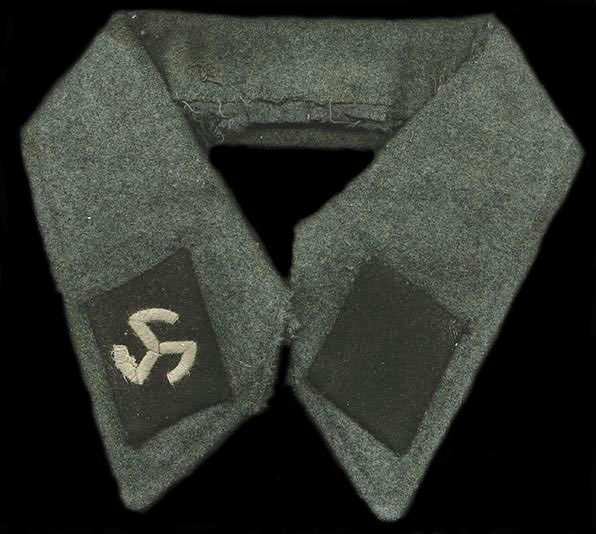
Trifos Collar Tab
|
|
In the
summer of 1940, the SS
Infantry Regiment "Nordland" and SS Infantry Regiment "Westland" composed of
Germanic Dutch, Flemish and Norwegian men were raised and would become one of the
three constituent regiments of the 5th SS Division "Wiking."
The
It should be noted that the Germans initially created another SS Infantry Regiment referred as the
"Standarte Nordwest"composed of Dutch men.
Unlike the volunteers in the Westland
Regiment who wore SS Collar Tabs, the volunteers in the Nordwest were granted the distinction of
their own special collar tab of a three-legged swastika referred as Trident sunwheel.
By September 1941 the Nordwest was disbanded, and its personnel distributed to them
respective ethnic legion formation.
Many of the transferees from the
disbanded Nordwest continued to wear their Trifos Collar Tab for a time in there
respective ethnic legions.
The Trifos collar tab was the standard insignia issued to the
"Freikorps Danmark." These
tabs were provided to Danish volunteers when they arrived at the training camp in
Hamburg, which included the aluminum bullion handmade Trifos for officers. It was
carried during the stay in Hamburg and also on arrival at the Posen-Treskau training
camp in September of 1941. However, it was immediately removed upon arrival to Posen
and replaced by the popular SS runes.
In May 1943 the Flemish Legion was
disbanded. Flemish legionnaires had the option of joining the newly formed
SS Assault Brigade "Langemarck."
Members of the Sturmbrigade and later the 27th SS Volunteer Grenadier Division
Langemarck were authorized to wear the Trifos collar tab.
The complete collar torn off a tunic was found somewhere in the Ukraine.
Has the proper stitching behind the collar with the tabs placed correctly,
one of the legs of the Trifos collar tab is damage a little nevertheless very rare.
|
Waffen-SS Foreign Volunteer Collar Tabs
|
|
The first SS clothing factory was established in Dachau concentration
camp, where the main SS clothing depot was also located.
With the
increasing recruitment of non-Germans into the Waffen-SS after 1940,
Himmler became concerned about the use of the SS runes insignia by those
not racially suitable for full SS membership, and he instructed that such
recruits should wear some form of collar tab without SS runes. The SS
thereafter designed and issued a range of appropriate collar tabs for its
foreign volunteers, and pending the distribution of these insignia blank
collar tabs were often worn in new formations as an interim measure.
German SS officers and NCOs serving in foreign units were still entitled to
wear the SS runes collar tabs and from July 1943, if they chose to
identify with their men they were obliged to sport the SS runes
embroidered below the left breast pocket instead.
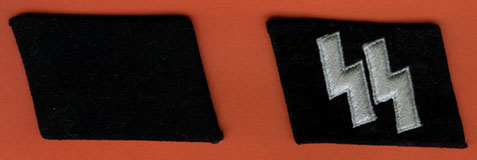
Above is a scarce blank collar tab worn by most foreign volunteers and "SD"
personnel. Next is a standard RZM pattern embroidered SS rune insignia.
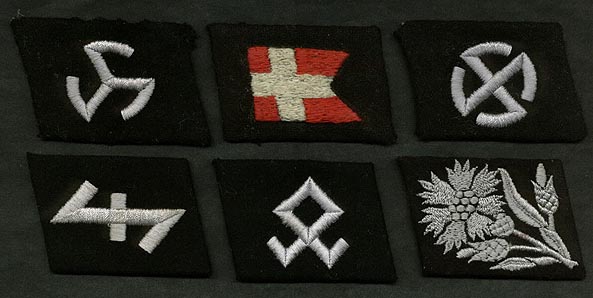
Above you'll find the German made Trifos Collar tab that was issued
to Danish volunteers in the Freikorps and later to Flemish volunteers
in the SS Assault Brigade "Langemarck."
Next is a very rare locally made Danish Freikorps collar tab.
The Freikorps collar tab was issued on 28 April 1942 and worn
for only 6 months. The Danish flag is embroidered on a black
wool cloth.
The "Sonnerad" (sunwheel) collar tab was issued to Nordic volunteers
incorporated in the SS-Panzergrenadier Rgt 23 Norge and SS-Panzergrenadier
Rgt 24 Danmark. These collar tabs were probably issued in May
1943 while the regiments were in the Grafenwohr training grounds.
The Sunwheel collar tab is the standard Dachau made tab.
Below you'll find a late pattern Dutch wolf-hook collar tab
(German issued in 1944). This collar tab was issued to Dutch
volunteers in the "4. SS Panzer-Grenadier Brigade Nederland."
In the middle is the "Odal" rune collar tab, issued around early
March 1942 to volunteers of the "7. SS-Freiwilligen-Gebirgs
Division Prinz Eugen." This division was a truly Germanic formation
comprised of ethnic Germans who lived in the Balkans.
Next is a collar tab issued to members of the "22. SS-Freiwilligen-Kavallerie-Division
Maria Theresia." This Division was comprised of ethnic Hungarian
Germans and Hungarians. The cornflower tab was issued in limited
quantities.
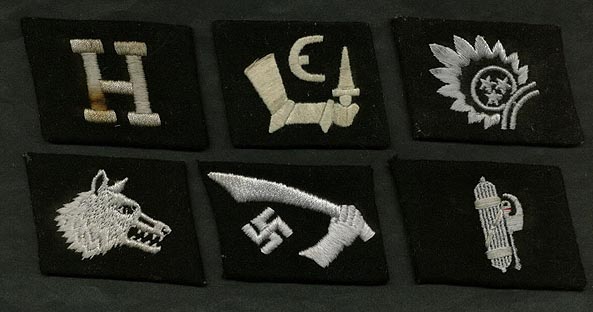
On
top you'll find the Hungarian Waffen-SS collar tab issued to
volunteers in the "25. Waffen-Grenadier Division der SS "Hunyadi."
Picture evidence shows that this "H" pattern collar tab was
issued and worn but in very limited quantities.
Next is a very rare locally made Estonian collar tab that was
worn by men in the "20. Waffen-Grenadier Division der SS Estnische."
The early pattern collar tab is machine embroidered. In addition
a metal type collar tab was also made and worn by Estonian volunteers.
The Germans produced an Estonian version collar tab, however
it was very unpopular with the troops that very few were worn.
Next is a late pattern Latvian collar tab, issued and worn by
volunteers in the "15. Waffen-Grenadier Division der SS Lettische."
Below is a Wolf's Head collar tab that was made for the "Ostturkische
Waffen-Verband der SS." In October 1944, this formation was
initially comprised of three separate eastern groups: Idel-ural,
Turkestan and Krim. By March 1945 the Aserbeidschan legion was
added. The German made Wolf's Head collar tab was never issued.
In late 1943, a special tab insignia was issued to members of
the "13. Waffen-Gebirgs Division der SS Handschar." The insignia
consisted of a hand holding a Simitar with a swastika.
Next is an Italian collar tab that was made for members of the
"29. Waffen-Grenadier Division der SS Italienische." The insignia
shows silver-grey fasces. There is no indication that this tab
was issued or worn.

Above is a German made collar insignia worn by members of the 14. Waffen-Grenadier Division
der SS Galizien. It was issued in late 1943 and shows the rampant lion of Galicia.
Next is SS collar issued late 1944 to members of the notorious SS Sturmbrigade Dirlewanger
made up of mostly criminals and poachers. The tab illustrates crossed rifles and a hand grenade
below.
Next is the Latvian SS collar tab showing the Latvian Fire Cross. This tab was mostly worn by
members of the 19. Waffen-Grenadier Division (Lettische Nr. 2).
| |









